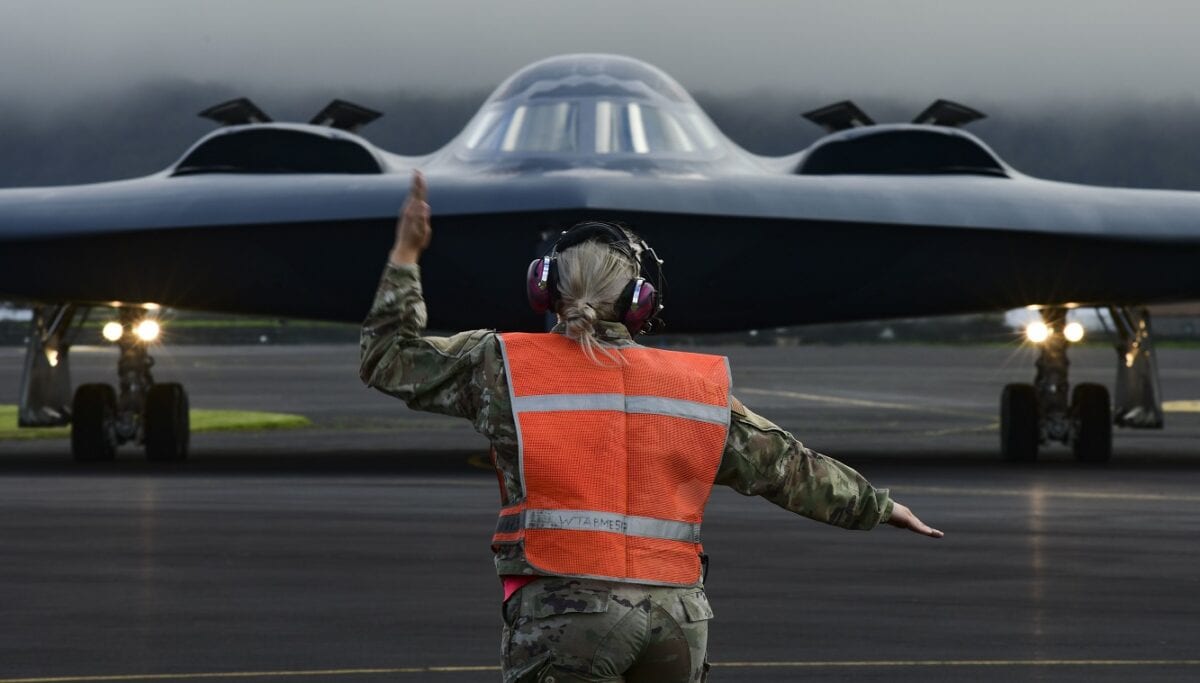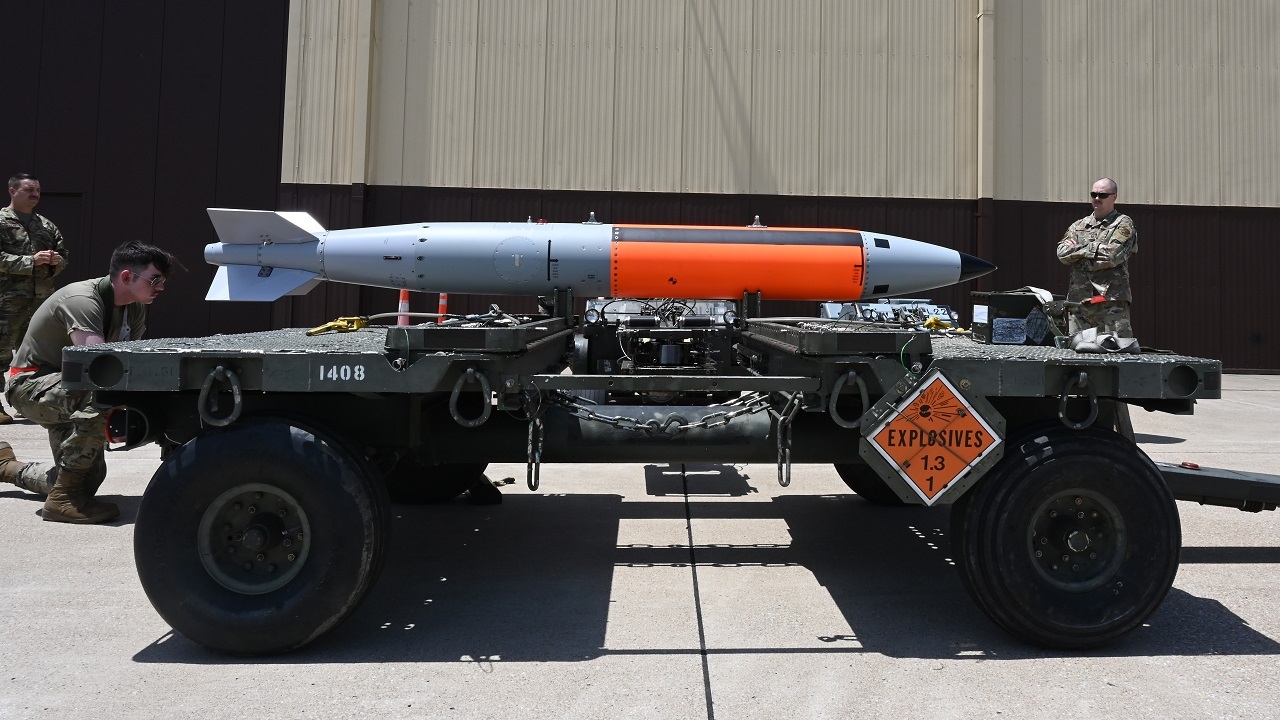Last month, the U.S. Air Force revealed a series of photographs from its Whiteman Base in Missouri on the Defense Visual Information Distribution Service (DVIDS). The photos depicted a dummy B61-12 Joint Test Assembly (JTA) being prepared to be loaded inside a B-2A Spirit stealth bomber’s pylon.

Crew chiefs assigned to the 393rd Expeditionary Bomb Squadron, prep a B-2 Spirit stealth bomber for take off, at Lajes Field, Azores, March 16, 2021. Three B-2s, assigned to Whiteman Air Force Base, Missouri, arrived at Lajes to hot-pit refuel prior to supporting several bomber task force missions in the high north. Strategic bomber missions are conducted periodically to enhance the readiness necessary to respond to challenges, in coordination with partner and allied nations, around the world. Members assigned to U.S. European Command regularly train, fight and live with allies and partners from bases in Europe, to ensure timely and coordinated responses when needed. (U.S. Air Force photo by Tech. Sgt. Heather Salazar)
The Air Force was likely testing the racks, ensuring the mock bomb could fit securely and function properly if needed. The B-2A and B61-12 JTA represent one of the three legs of the U.S. nuclear triad; which serves as the backbone of America’s national security platform. The Air Force’s strategic bombers perform the air-based nuclear needs of the nation along with its Intercontinental Ballistic Missiles (ICBM), which perform the land-based functions.
The U.S. Navy’s Submarine Launched Ballistic Missiles (SLBM) Trident IIs make up the country’s sea-based nuclear deterrence, which are launched from Ohio-class vessels. Together, these three systems – bombers, missiles, and submarines – provide both first-strike and retaliatory capabilities to ensure U.S. nuclear deterrence strategy.
A Major Milestone
The Pentagon’s Inspector General Office said that it would investigate the Air Force’s aircraft approval process for carrying the new B61-12 JTA nuclear bomb. In June 2020, the Air Force approved the F-15E Strike Eagle multirole jet to deliver the B61-12 bomb, making the airframe the first fighter to become certified to do so.
Brig. Gen. Ty Nueman, the principal assistant deputy administrator for military application at the National Nuclear Security Administration (NNSA) said that the success of the F-15E tests was a “major milestone” for the Air Force, adding that “Once delivered, this capability will underpin our nation’s deterrent and strengthen our NATO partnerships.”
About a year and a half later, two F-35A Lightning II fighters successfully released B61-12 bombs during the airframe’s first Full Weapon Demonstration. According to details released by the Air Force, “The nuclear certification is broken into two phases: nuclear design certification and nuclear operational certification. This test is considered the graduation flight test exercise for the F-35A nuclear design certification and concludes on-aircraft testing for the initial nuclear certification effort.”

An F-35A Lighting II carrying a B61-12 Joint Test Assembly sits on the flight line at Nellis Air Force Base, Nevada, Sept. 21, 2021. Two F-35A Lightning II aircraft released B61-12 Joint Test Assemblies during the first Full Weapon System Demonstration, completing the final flight test exercise of the nuclear design certification process. (U.S. Air Force photo by Airman 1st Class Zachary Rufus)
An F-35A Lighting II carrying a B61-12 Joint Test Assembly sits on the flight line at Nellis Air Force Base, Nevada, Sept. 21, 2021. Two F-35A Lightning II aircraft released B61-12 Joint Test Assemblies during the first Full Weapon System Demonstration, completing the final flight test exercise of the nuclear design certification process. (U.S. Air Force photo by Airman 1st Class Zachary Rufus).
The B61-12 weapon is the latest variation in an ongoing modernization program for the B61 nuclear gravity bomb. The original prototype was designed and constructed by the Los Alamos National Laboratory in New Mexico in the mid-1960’s. Over the last five decades, the weapon has undergone 15 variations, although several of the variants had been canceled.
Bombs Away
Today, five versions of the B61 bomb remain in the U.S. arsenal; the B61-3, B61-4 and B61-10 tactical bombs; the B61-7 strategic bomb and the B61-11 strategic earth-penetrating bomb. In 2021, the NNSA said it had successfully completed its B61-12 Life Extension Program, “The B61-12 will replace the B61-3, 4, and 7. The B61-12 LEP (Life Extension Program) refurbishes, reuses, or replaces all of the bomb’s nuclear or non-nuclear components to extend the service life by at least 20 years.”
The latest B61-12 variation features specialized modifications that set it apart from its predecessors. Two of the bomb’s enhancements include an earth penetration capability in addition to guidance through a new guided tail kit assembly, which improves the precision of the weapon. The greater accuracy of the weapon, coupled with its capability to conduct a subsurface burst detonation, is “meant to “take advantage of these yields, the highest of which (50 kilotons) is considerably lower than the 400 kiloton setting on older B61 bombs,” according to a nuclear weapons expert at the Carnegie Endowment for International Peace. The B61 is currently based overseas in several U.S.-allied countries, including Italy, Belgium, and Germany,
In addition to its superior attributes, a main priority for the latest B61 variant is its ability to be “air-delivered on both current and future platforms to meet Department of Defense requirements,” according to an NNSA Administrator.
While the U.S. is getting close to this goal, other U.S. adversaries are also ramping up efforts to achieve a similar objective. In June, Russian President Vladimir Putin said that Moscow would work on upgrading its Sukhoi Su-25 fighter jets to make them nuclear-capable. The Russian president also said that Moscow would provide nuclear-capable Iskander-M missiles to Belarus amidst the Kremlin’s ongoing invasion of Ukraine.
The U.S. is one step closer to possessing fighter jets that can carry the B61-12 JTA bomb. However, the Pentagon began a probe last month that will ascertain whether the Air Force fully complied with federal requirements when the fighters were initially certified in 2020 and 2021. While the B61-12’s upgrades are impressive, its premiere function will always be deterrence. Hopefully this weapon will never need to be utilized in the future.
Maya Carlin is a Middle East Defense Editor with 19FortyFive. She is also an analyst with the Center for Security Policy and a former Anna Sobol Levy Fellow at IDC Herzliya in Israel. She has by-lines in many publications, including The National Interest, Jerusalem Post, and Times of Israel.

